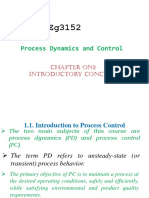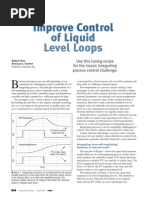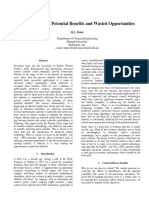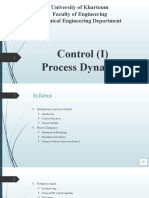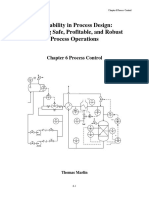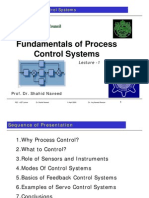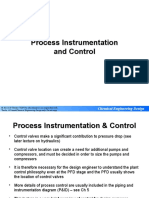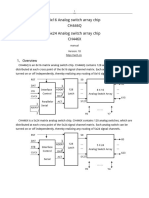Process Instrumentation and Control System
Uploaded by
Morgen MukamwiProcess Instrumentation and Control System
Uploaded by
Morgen MukamwiProcess Instrumentation
and Control System
Present By: Prakash Bahadur Thapa
Memorial University
St. Johns Newfoundland Canada
Email: pbt750@mun.ca
Tel: (1) 709 – 330 8666
Process Instrumentation & Control
Control valves make a significant contribution to pressure drop
(see later lecture on hydraulics)
Control valve location can create a need for additional pumps
and compressors, and must be decided in order to size the
pumps and compressors
It is therefore necessary for the design engineer to understand
the plant control philosophy even at the PFD stage and the PFD
usually shows the location of control valves
More details of process control are usually included in the
piping and instrumentation diagram (P&ID) – see Ch 5
This lecture is a very brief overview of control for design
purposes – more will come in your process control class
Chemical Engineering Design
Process Instrumentation & Control
Basics of process control
Process instrumentation
Reading a P&ID
Control of unit operations
Process safety instrumentation
Plant-wide control and optimization
© 2012 G.P. Towler / UOP. For educational use in conjunction with
Towler & SinnottChemical Engineering Design only. Do not copy
Chemical Engineering Design
Objectives of Process Control
Ensure stable process operation
Particularly, keep the plant operating under
safe conditions
Minimize damage to equipment due to variation
in plant conditions
Ensure operation meets product specifications
Minimize impact of external disturbances
Example: change in ambient temperature
Optimize process performance
Maintain process throughput
Minimize operating costs
Chemical Engineering Design
Control Loop Components
Instrument line
Alarms
PV PAH PIC
Actuator PT
PAL
Controller
Process or
utility stream
Final control Sensing
element element
The sensing instrument detects the measured variable and sends a
signal to a controller, which signals the actuator to close or open a
control valve and adjust the manipulated variable (usually a flow rate)
Chemical Engineering Design
Control Valves
The final control
element is usually a
Actuator control valve
Exceptions: electric
heaters, mixers,
variable speed
drives
The actuator is either
a motor or a bellows
that opens or closes
the valve in response
Valve
to the signal
Chemical Engineering Design
Types of Control Loop
Feedback Feed Forward
Control system measures Control system
changes in a process output and measures disturbance
then adjusts manipulated and adjusts
variable to return output to set manipulated variable to
point compensate for it so
that controlled output
Can be slow if process response
is not affected
time is long
Requires greater
Disturbance knowledge of system
response
Disturbance
Manipulated Process Controlled
variable output Controller
Controller Manipulated Process Controlled
variable output
Chemical Engineering Design
Feedback Control
Error Controller
Set + signal Function
point - generator
Input Output
Sensing Final control
element element
Measured variable Manipulated variable
Process
Controller computes error between input and set point and adjusts
output based on a control algorithm
Chemical Engineering Design
Typical Control Algorithms
P: Proportional SP
Controller output is proportional to error
The proportionality constant is called the controller gain
High gain gives fast response, but can lead to instability
Low gain can cause offsets time
I: Integral
Output is proportional to integral of error
Eliminates offsets from P control, but makes response more sluggish
D: Derivative
Output is proportional to rate of change of error
Damps out instability and allows higher gain to be used
Other functions such as summation, multipliers, and advanced models can
be easily coded in digital controllers
Chemical Engineering Design
PID Controller Response
For a PID Controller,
t
de
Controller Output = G e + (1 / T i) e dt - T d
o dt
where: G = Controller gain
e = Error (set point minus measured variable)
Ti = Integral time constant
Td = Derivative time constant
The controller output is proportional to the error, the time
integral of the error, and the rate of change of the error. G, Ti
and Td are the controller tuning parameters.
Much more of this in control class
Chemical Engineering Design
Ratio Control
One stream is controlled
in ratio to another
Often used for FT
controlling feed rates to
try to maintain FFC
stoichiometry FFV
Also used in some types FT
of distillation column
control to set reflux or
boil-up ratios
Chemical Engineering Design
Cascade Control
One primary controller is used to adjust the set point of a
second secondary controller
Used to minimize outside load variations and increase process
stability
• Example: reactor
temperature (primary
controller) cascades
onto coolant flow
controller (secondary)
to control reactor
temperature
Chemical Engineering Design
Process Instrumentation & Control
Basics of process control
Process instrumentation
Reading a P&ID
Control of unit operations
Process safety instrumentation
Plant-wide control and optimization
Chemical Engineering Design
What Can Be Measured?
(& How Easily)
Easy Difficult
Temperature
L/L level
Pressure
pH
Flow rate
Certain components
oxygen, sulfur, hydrogen,
V/L Level CO
Pressure difference Composition
Conductivity Density
Voidage
• Easy means cheap, reliable instrument with fast response time
and accurate measurement
Chemical Engineering Design
Temperature Measurement:
Thermocouples
When a junction between dissimilar wires is
heated, an EMF (voltage) is developed, which
can be read by a millivolt transmitter
The junction is usually housed in a
thermowell
THERMOCOUPLE HEAD
LEAD WIRE
A A + Cu
MILLIVOLT
TRANSMITTER
B B - Cu
HOT JUNCTION (T1 )
COLD JUNCTION (T2 )
ISA TYPE A (+) B (-)
E CHROMEL CONSTANTAN Typical
J IRON CONSTANTAN
K CHROMEL ALUMEL High T
T COPPER CONSTANTAN
Chemical Engineering Design
Temperature Measurement:
Thermocouples
Response depends on thermowell location and heat
transfer
Instrument error is usually 3 to 4 F
Theremay be additional offsets if the
thermowell is incorrectly located
Response is fast if located in a flowing stream
Sometimes thermocouples are also strapped to
walls of vessels
For high temperature processes or processes
with large exotherms
Chemical Engineering Design
Pressure Measurement
Pressure instruments usually measure differential pressure
If one side is atmospheric pressure then the difference is the
process gauge pressure (usually written barg or psig), not
absolute pressure (bara, psia)
Several possible methods:
Mechanical: measure displacement of a bellows or Bourdon tube
Electrical: attach a strain gauge to a bellows
Capacitance: diaphragm moves capacitor plate (most common type)
Piezoelectric: measures change in semiconductor conductivity
Pressure measurement devices respond quickly and accurately
Differential pressure measurement is used as the basis for flow
and level measurement
Chemical Engineering Design
Flow Rate Measurement
Place a restriction in the flow path and measure the resulting pressure
drop using a differential pressure (PD) cell
If fluid properties are known, results can be calibrated to flow rates
PD PD
Orifice Meter Venturi Meter
Chemical Engineering Design
Level Measurement
Displacement Differential Pressure
Displacer moves up and
Measures static head
down with level due to of liquid using a
bouyancy differential pressure
cell
Displacer movement is
detected via mechanical or
Density of the liquid
magnetic linkage and vapor must be
known and constant
Sensor element
PD
Chemical Engineering Design
Composition Measurement
Some components can be detected at low concentrations using sensors
that have been designed to pick up that component
Examples: O2, CO, H2S, H2
Component sensors are often sensitive to other components, so check
carefully with vendor to make sure the device is rated for the application
More detailed composition can be measured by on-line GC methods
TCD: thermal conductivity detector
FID: flame ionization detector
Response can be slow (5 to 30 minutes), particularly if a long column is used
Online NIR can be used in some cases
Composition is often inferred from other properties
Boiling point
Conductivity
Chemical Engineering Design
Process Instrumentation & Control
Basics of process control
Process instrumentation
Reading a P&ID
Control of unit operations
Process safety instrumentation
Plant-wide control and optimization
Chemical Engineering Design
Piping and Instrument Diagrams
The P&ID shows all the instruments and valves in the process
Not just control loops
Vents, drains, sample points, relief valves, steam traps, isolation
valves, etc.
The P&ID usually also indicates line sizes and pipe metallurgy
Companies occasionally use their own symbols, but U.S.
standard is ISA-5.1-1984 (R1992) from the International Society
for Automation
The P&ID is usually produced in consultation with a specialist
controls engineer
Example of real P&ID: see Ch5
Chemical Engineering Design
ISA 5.1 P&ID Symbols
Control Valves
General Three-way Globe Diaphragm
Actuators
S D M
Diaphragm or Solenoid Digital Rotary motor
unspecified
actuator
Chemical Engineering Design
Valve Failure Positions
Fails open Fails closed Fails locked in Failure mode
current indeterminate
position
It is important to specify what happens to a control
valve if the signal fails
The final valve position has an impact on process
safety and pressure relief scenarios and may affect
other instrumentation
Chemical Engineering Design
ISA 5.1 Instrument Lines
Most newer plants use
Instrument supply or connection to process electric signals
Undefined signal Pneumatic signals are
found in older plants
Pneumatic (instrument air) signal and locations where
electric signals would
be unsafe
or Electric signal (4 to 20 mA)
Binary signals are used
for digital signals and
for solenoids and other
or Electric binary (on-off) signal on-off devices
Instrument lines are
Internal system link (software or data always drawn lighter
link) than process lines on
the P&ID
Chemical Engineering Design
ISA 5.1 Controller Symbols
Field mounted Panel mounted Panel mounted in Dual function
in primary auxiliary location instrument
location (local panel)
Distributed Control Shared Display Symbols
Field mounted shared display device with limited access to
adjustments
Shared display device with operator access to adjustments
*AH
*AL Shared display device with software alarms (* is measured variable)
Chemical Engineering Design
Shared Display Devices
Most plant control rooms
now use shared display
devices that show the
outputs of multiple
instruments on a VDU screen
Operator can see a flow
diagram that identifies
where the instrument is and
can enter set points
Software also allows data to
be plotted as trends
Data can be accessed
remotely Source: UOP
Data is collected and logged
for process records
Chemical Engineering Design
ISA 5.1 Nomenclature
PIC
Pressure Indicator Controller
Two- to four-letter codes are used to identify the
instrument or controller
First letter always indicates the initiating or
measured variable
Subsequent letters I = indicator, R = recorder, C =
controller, T = transmitter, V = valve, Z = other final
control element, S = switch, Y = compute function,
AH = high alarm, AL = low alarm
Chemical Engineering Design
ISA 5.1 Nomenclature: First Letters
A Analysis (composition) Q Quantity
F Flow R Radiation
FF Flow ratio T Temperature
J Power TD Temperature
differential
L Level
P Pressure (or vacuum)
W Weight
PD Pressure differential
C, D, G, M, N, O can be
user-defined variables
Chemical Engineering Design
Exercise: Identify The Instrument
Can you figure out what each of these ISA 5.1 codes
means and what the instrument does?
TRC
AR
PAH
PAHH
LI
PC
TSH
FFY
PT
JIAL
Chemical Engineering Design
ISA 5.1 Other Common Symbols
Restriction orifice Pressure Hand control valve Gate valve or
relief or isolation valve
safety valve
Self-contained Stop check (non-
backpressure return) valve
regulator
Chemical Engineering Design
Process Instrumentation & Control
Basics of process control
Process instrumentation
Reading a P&ID
Control of unit operations
Process safety instrumentation
Plant-wide control and optimization
Chemical Engineering Design
Level Control
A level control is
needed whenever there
LAH LIC
is a V/L or L/L interface
LT LAL
Level control sets
inventories in process
equipment
Many smaller vessels
are sized based on level
M
LV
control response time
Chemical Engineering Design
Pressure Control
Pressure control is usually
by venting a gas or vapor
In hydrocarbon processes, PV
off-gas is often vented to
fuel
In other processes,
nitrogen may be brought in
to maintain pressure and PT
PIC
vented via scrubbers
Most common arrangement
is direct venting (shown)
Several vessels that are
connected together may
have a single pressure
controller
Chemical Engineering Design
Pressure Control
PV
If vapor has a high
loading of
condensable
material, then
pressure control is on
the vent gas stream
from the condenser PIC
PT
Chemical Engineering Design
Pressure Control: Condensers
Coolant PIC
PT PV
Process
vapor
Process PIC
PT
PV
Coolant
Alternatively, for a condenser, we can control the
coolant supply or the heat transfer surface (by
varying the liquid level)
These methods control pressure by changing the
rate of condensation
Chemical Engineering Design
Flow Control
Most common arrangement is a control valve
downstream of a pump or compressor
Using a variable speed drive is a more efficient
method, but higher capital cost
FIC FIC
FV
PI M PI FT
FT
Chemical Engineering Design
Flow Control: Reciprocating Pump
FIC
Reciprocating pumps and
FY
compressors and other
positive displacement
FV devices deliver constant
FI flow rate
FI
Flow can be controlled by
manipulating a spill-back to
PI FT the pump feed
FT
Chemical Engineering Design
Flow Control: Vaporizer
FIC
Vapor
Vaporizer flow control needs
LIC to prevent liquid accumulation
FT
FV Hence use level controller to
actuate heat input to the
LV
vaporizer and maintain a
LT constant inventory
Feed Control of liquid flow in is
easier than control of vapor
Steam flow out
Trap
Condensate
Chemical Engineering Design
Temperature Control: Single Stream
Heaters and coolers are
Hot or cold usually controlled by
manipulating the flow rate
utility of the hot or cold utility
stream
Process Final control element can be
on inlet or outlet of utility
TE TT
TIC side
TV
Chemical Engineering Design
Temperature Control: Heat Exchangers
Temperature control for an
exchanger is usually by
manipulating the flow
through a bypass
Only one side of an
TIC
TE TT exchanger can be
temperature controlled
TV
• It is also common to see exchangers with no
temperature control and have temperature control on
the downstream heater and cooler
Chemical Engineering Design
Temperature Control: Air Coolers
M M M M
TV
TO VARIABLE
TIC SPEED MOTOR TIC
TE TT TE TT
CONTROL CIRCUIT
Ambient air temperature varies, so air coolers are oversized and
controlled by manipulating a bypass
Alternatively, air cooler can use a variable speed motor, louvers or
variable pitch fans – see lectures on heat exchange equipment
Chemical Engineering Design
Distillation Control
Distillation control is a specialized subject in its own right
In addition to controlling condenser pressure and level in the sump,
a simple distillation column has two degrees of freedom
Materialbalance (split) and energy balance (heat input or
removed)
Therefore needs two controllers
Therefore has the possibility that the controllers will interact
and “fight” each other
Side streams, intermediate condensers & reboilers, pump-arounds,
etc. all add extra complexity and degrees of freedom
There are several good books on this subject
Kister, H.Z., 1989, Distillation Operation, McGraw-Hill
Luyben, W.L. 2006, Distillation Design and Control Using
Aspen Simulation, Wiley
Chemical Engineering Design
Distillation: Temperature Pattern Control
Tray temperature is used to
infer composition
Composition is used to adjust
reflux rate and reboiler heat
TC input
Tray locations for temperature
detectors need to be chosen
carefully
Controllers can fight each other
LC
TC
– not a good scheme
Material balance control
schemes are more robust
Steam
Chemical Engineering Design
Distillation: Material Balance Control
PC
Direct control of
LC distillate composition
by using tray
temperature to infer
composition and
TC control distillate flow
rate
Flow control on
(constant) boil-up
LC
rate could be set in
FC ratio to feed if feed
flow rate was highly
variable
Chemical Engineering Design
Distillation: Material Balance Control
PC
Indirect control of
distillate composition
LC
by using tray
temperature to infer
TC
composition and
control reflux rate
Flow control on
LC
(constant) boil-up
FC
rate could be set in
ratio to feed if feed
flow rate varies
Chemical Engineering Design
Distillation: Material Balance Control
PC
Direct control of
LC
bottoms composition by
FC
using tray temperature
to infer composition
and control bottoms
flow rate
TC
Flow control on
LC
(constant) reflux rate
could be set in ratio to
feed if feed flow rate
varies
Chemical Engineering Design
Distillation: Material Balance Control
Indirect control of
PC
LC
bottoms composition
FC by using tray
temperature to infer
composition and
control boil-up rate
Flow control on
TC
(constant) reflux rate
LC
could be set in ratio
to feed if feed flow
rate varies
Chemical Engineering Design
Batch Distillation
FV
FT
FIC
TE
FIC TT FY
FT FV
Intermittent
Steam drain
Intermittent Trap
charge
Reflux flow control adjusted based on temperature (used to infer
composition)
Chemical Engineering Design
Reactor Control
Control of flow is usually carried out on cold reactor feeds
Flows are often ratio controlled to get close to desired
stoichiometry or maintain desired excess of one feed
Pressure control is on reactor vapor outlet or on vent space
Level control maintains inventory for liquid phase reactors
Temperature control can be
On feeds
On heating or cooling jacket
On recirculation through external heaters or cooler
By controlling flow of quench/reheat streams
Chemical Engineering Design
Typical Stirred Tank Reactor Control Scheme
PIC
PT
To vent
system
M
FIC
FV FT
Feed A
FIC TT
TIC FIC
FV FT
LAH LIC
LT
TE LA
FV L
FT
Feed B
Coolant
Temperature cascade
Product
control of coolant flow
Independent flow control
of feeds
Chemical Engineering Design
Exercise: Gas Recycle Process
Make-up
gas Purge
Feed
Reactor
Product
Remember the simple flowsheet introduced in the lecture on
simulation?
Liquid feed is mixed with recycle gas, heat exchanged against reactor
effluent, heated to reactor temperature then passed over fixed bed of
catalyst. Product is cooled and liquid product is recovered.
Unconverted gas is recycled with purge to prevent accumulation of
inerts
Chemical Engineering Design
Exercise: Gas Recycle Process
Make-up
gas Purge
Feed
Reactor
Product
What controllers would you use?
Where would you place them?
Chemical Engineering Design
Process Instrumentation & Control
Basics of process control
Process instrumentation
Reading a P&ID
Control of unit operations
Process safety instrumentation
Plant-wide control and optimization
Chemical Engineering Design
Role of Controls in Process Safety
Control system is involved in
three levels of process safety
Keeping plant operation
steady
Sounding alarms to notify Emergency Response
in Community
operator when variables are Emergency Response
in Process Unit
out of limits Pressure Relief System
Automaticallyshutting the Automatic
AutomaticSafety
SafetyShutdowns
Shutdowns
plant down when necessary
Critical Alarms & Operator Intervention
Basic Process Control
Plant Design (Inherent Safety)
Chemical Engineering Design
Process Control, Alarms and Shutdowns
Variable
AH
Set point
AL time
Shutdown
Controlled parameters naturally fluctuate around set point
If the measured variable exceeds a preset limit an alarm should alert the
operator to take appropriate action
Alarm limits should be set far enough from normal process variation to avoid
nuisance alarms
If the measured variable exceeds a safe operating limit then an
automatic plant shutdown may be necessary
Shutdown limit should be set far enough from alarm limit that the operator has a
chance to respond to the alarm
But not so far that no time is left to safely shut the plant down
Chemical Engineering Design
Standards for Safety Instrumentation
ISA S84.01 Safety Instrumented Systems
U.S. standard for emergency shutdown systems
Primary goal is to protect people, not plant or profits
ISA S84.01 = IEC 61511
IEC 61508 & 61511
IEC = International Electrotechnical Commission
International standards for safety instrumented systems
Standards define requirements for sensors, solvers (logic), and
final elements (valves, switches)
Consult most recent version of standards for current best practices
Other standards also recommend best practices for alarm levels,
vessel sizing to allow adequate control, etc.
Chemical Engineering Design
Safety Integrity Levels
ISA S84.01 defines three levels of safety integrity
depending on the availability of the SIS
Availability = time the system is available / total time
Safety Integrity Levels
SIL Availability System redudancy
SIL 1 90 – 99% Non-redundant
SIL 2 99 – 99.9% Partially redundant
SIL 3 99.9 – 99.99% Totally redundant
Redundant system means instrumentation is duplicated
Chemical Engineering Design
Safety Integrity Level
SIL should be determined during a process
hazard analysis (see Ch10 and lectures on
process safety)
SIL required depends on risk of operator
exposure and injury
Can be calculated using fault trees
See Ch10 and later lecture
SIL determines the type of instrumentation that
should be used
Chemical Engineering Design
Process Alarms and Shutdown Trips
LIC LIC
LT LT
LAL LAL
TRIP
LSL LAL
UC
A
UC
A
Software alarms can be set on instruments and controllers through
the digital control system and show up on shared displays
Separate alarm and shutdown instrumentation can also be used,
for higher redundancy
Chemical Engineering Design
Caution on Software Alarms
There is a temptation to put lots of software alarms in digital
control systems
If there are too many alarms then they can become a
distraction to the operators
Increasing the chance of human error
Increasing the chance that the operator will ignore the
alarm, switch it off, or acknowledge it without taking action
Increased chance of an “alarm flood”
Alarms should be carefully placed and calibrated to make sure
that they serve the purpose of the designer
Operators should be trained to understand the importance of
every alarm on the plant
Chemical Engineering Design
Process Instrumentation & Control
Basics of process control
Process instrumentation
Reading a P&ID
Control of unit operations
Process safety instrumentation
Plant-wide control and optimization
Chemical Engineering Design
Plant-Wide Control
(Advanced Process Control, APC)
All new plants and most older plants have the instruments and
controllers connected to a plant-wide digital control system (DCS).
Using the DCS:can update individual controller set points via shared
Operators
displays
Plant information systems can log data
Feedforward and multivariable predictive control can be
implemented more easily
Plant real-time optimization can be implemented through the
control system
Most controllers now have microprocessors built into them, so the
computational capacity that is needed is not necessarily located in
the control room
Chemical Engineering Design
Plant-Wide Control Issues
Where do we control inventories?
All vessels that have a liquid level
Do we need extra surge volume to keep operations steady?
Where is the best place to control pressure?
Single PC setting plant back-pressure?
Need for different pressure levels?
Where is best place to control material balance?
Can only control flow in one place per feed stream
Control after removing contaminants?
Ratio control?
What about recycles?
Chemical Engineering Design
Plant-Wide Control Issues
Where is best place to control temperatures?
Heaters and coolers only?
Control of heat exchanger networks?
How do we meet product specifications?
Use of on-line analytical instruments?
Inference through bubble point?
Sampling of product storage tank?
How do we optimize the process?
Maximize throughput and product yield while staying on
spec?
Minimize cost of production?
Maximize time on stream between shutdowns?
Chemical Engineering Design
Multivariable Predictive Control
What if we have three manipulated variables that
interact with each other through non-linear
equations?
Measured variable 1
Measured variable 2
Measured variable 3
Control Valve 1
Control Valve 2
Control Valve 3
• Single Input Single Output (SISO) controllers will
have a hard time responding and will tend to have
strong interactions with each other (tendency to
fight)
Chemical Engineering Design
Multivariable Predictive Control
In this situation, instead of SISO controllers we need
a Multiple Input Multiple Output (MIMO) controller
The controller algorithm is a model that captures the
non-linear interaction between the manipulated
variables
Does not have to be a “fundamental” model
Does have to capture dynamic response
Can be tuned from plant operation
Hence another name for multivariable predictive
control is model-based predictive control
With MIMO devices, there is no longer a direct pairing
of measured and manipulated variables as in the
earlier unit operations examples
Chemical Engineering Design
MIMO Example: Gas Mass Flow Controller
FY FIC
FV
FT PT TT
Gas mass flow cannot be measured or controlled
directly
By measuring volume flow, temperature and pressure
we can compute mass flow as long as composition is
known and steady
This is actually MISO, not MIMO, but the FY could talk
to another device such as a ratio controller
Chemical Engineering Design
Device Communication Standards
Now that individual controllers (and even
instruments) contain microprocessors, the
computational power of the DCS is distributed
To make best use of this distributed
computation power, the devices need to be
able to communicate with each other
Communication standards are set by ISA, IEC
and the controller manufacturers and are
currently evolving rapidly
Chemical Engineering Design
Evolution of Controller Communication Standards
Manual Control
Pneumatic Analog
Electronic Analog
Digital
Fieldbus (ISA SP50)
Wireless (ISA SP100)
?!?!?!?
Source: UOP
Chemical Engineering Design
Fieldbus (ISA SP50)
Digital device
communication protocol
that allows “plug and
play” connection of
devices
Requires less wiring and
gives greater reliability
through redundancy
Different control
companies have variations
on the standard, so system
compatibility and
interoperability are issues
Source: UOP
Chemical Engineering Design
Wireless Communication (SP100)
Advantages Problems
No cable runs Interference from
Quicker and cheaper other wireless
to set up devices
Portable control
Signal blocking due
room to steelwork
Improved safety
Signal loss creates
need for greater
(electric cables are
easily damaged by redundancy
fires)
The controls companies are currently putting a lot of effort into developing the devices and
standards for implementing wireless control
Chemical Engineering Design
Real Time Optimization
A DCS can be programmed to carry out
optimization of plant performance by Optimizer
updating controller set points and MPC
Targets for KPIs
algorithms
The optimizer is usually a higher level DCS
program that runs less frequently and
is used to adjust set points Set points
periodically by computing target
values for key performance indicators Controllers
(KPIs)
Adjust
The optimizers used for RTO are often manipulated
not very sophisticated – typically LP, variables
MILP or simple NLP models Plant
Chemical Engineering Design
Types of Real-time Optimization
Optimizer
User User
Plant DCS
Off-line Optimization
Users take plant data and run the optimizer then send instructions to the
plant operators to update the DCS settings
Labor intensive and difficult to update more than daily
Chemical Engineering Design
Types of Real-time Optimization
Optimizer Optimizer
User User User
User
Plant DCS Plant DCS
Off-line Optimization Open Loop On-line Optimization
Users provide input to optimizer, DCS updates
optimizer directly with plant settings and user
updates DCS with new targets
Chemical Engineering Design
Types of Real-time Optimization
Optimizer Optimizer
User User User User
Plant DCS Plant DCS
Off-line Optimization Open Loop On-line Optimization
Optimizer Users only provide input to the
optimizer and the DCS is
updated directly by the
User optimizer
Plant DCS
Closed Loop On-line Optimization
Chemical Engineering Design
Real Time Optimization Models
Models and algorithms for RTO have very tough requirements
Must be robust, i.e., always find a solution
Must solve quickly
Must converge to same solution whatever the starting point
Must allow for model error
Must reconcile data and filter out bad data
Must capture plant constraints
Must give reasonably good description of plant performance
Hence frequent use of simple LP models
Controls companies spend a lot of time setting up and tuning models
Chemical Engineering Design
Questions ?
Chemical Engineering Design
You might also like
- Automatic Control System and Control Loops100% (1)Automatic Control System and Control Loops60 pages
- Chapter 1 (Part 2) : Basic Concepts 1.4 Process Variables: Marmy Roshaidah Mohd SallehNo ratings yetChapter 1 (Part 2) : Basic Concepts 1.4 Process Variables: Marmy Roshaidah Mohd Salleh47 pages
- Lecture 1 Introduction To Control SystemNo ratings yetLecture 1 Introduction To Control System14 pages
- Part 5: Advanced Control + Case StudiesNo ratings yetPart 5: Advanced Control + Case Studies52 pages
- Process Control Chap 8 Feedforward, Ratio ContolNo ratings yetProcess Control Chap 8 Feedforward, Ratio Contol17 pages
- Lecture 10 - Multiple Control Loops - 2023No ratings yetLecture 10 - Multiple Control Loops - 202326 pages
- EE 351 Principles of Control Systems IntNo ratings yetEE 351 Principles of Control Systems Int52 pages
- Control Strategies For Water Level Control of Two Tank System 11 AugNo ratings yetControl Strategies For Water Level Control of Two Tank System 11 Aug7 pages
- Datta Meghe College of Engineering, AiroliNo ratings yetDatta Meghe College of Engineering, Airoli39 pages
- Instrumentation and Process Control CH 2022100% (2)Instrumentation and Process Control CH 202220 pages
- Chapter 10 - Stability of Closed-Loop Control SystemsNo ratings yetChapter 10 - Stability of Closed-Loop Control Systems27 pages
- Complete Download Surveys in Geometry I Athanase Papadopoulos PDF All Chapters100% (3)Complete Download Surveys in Geometry I Athanase Papadopoulos PDF All Chapters37 pages
- Szpir, Michael, GÇÿNasty, Brutish and Short-GÇÖ, American Scientist, 1993, 81-4, Pp. 328-29No ratings yetSzpir, Michael, GÇÿNasty, Brutish and Short-GÇÖ, American Scientist, 1993, 81-4, Pp. 328-293 pages
- Electromagnetic Spectrum Research Activity C12-2-01No ratings yetElectromagnetic Spectrum Research Activity C12-2-013 pages
- To Opt For Coatex Rheology Modifiers: To Develop High-Performance and Low Impact CoatingsNo ratings yetTo Opt For Coatex Rheology Modifiers: To Develop High-Performance and Low Impact Coatings18 pages
- An Interview With Samuel Hahnemann by Iman NavabNo ratings yetAn Interview With Samuel Hahnemann by Iman Navab74 pages
- Download ebooks file Ethics for Engineers Martin Peterson all chapters100% (4)Download ebooks file Ethics for Engineers Martin Peterson all chapters66 pages
- Theory and Applications of Monte Carlo Simulations 2013No ratings yetTheory and Applications of Monte Carlo Simulations 2013284 pages
- When Can Transformers Reason With Abstract Symbols?No ratings yetWhen Can Transformers Reason With Abstract Symbols?55 pages
- Myelin - The Brain's Supercharger (PDFDrive)No ratings yetMyelin - The Brain's Supercharger (PDFDrive)324 pages
- Final Oral Exam: The Mystery of The Bermuda TriangleNo ratings yetFinal Oral Exam: The Mystery of The Bermuda Triangle3 pages
- NTA UGC NET Management Paper 2 June 2014No ratings yetNTA UGC NET Management Paper 2 June 201416 pages
- 1st Term Syllabus Class 6 Maths The City School100% (1)1st Term Syllabus Class 6 Maths The City School3 pages
- Magic Square 10x10 Siva Parvati A MeetingNo ratings yetMagic Square 10x10 Siva Parvati A Meeting4 pages
- Complete Download The Naqab Bedouin and Colonialism New Perspectives 1st Edition Mansour Nasasra PDF All Chapters100% (8)Complete Download The Naqab Bedouin and Colonialism New Perspectives 1st Edition Mansour Nasasra PDF All Chapters85 pages
- Chapter 1 (Part 2) : Basic Concepts 1.4 Process Variables: Marmy Roshaidah Mohd SallehChapter 1 (Part 2) : Basic Concepts 1.4 Process Variables: Marmy Roshaidah Mohd Salleh
- Control Strategies For Water Level Control of Two Tank System 11 AugControl Strategies For Water Level Control of Two Tank System 11 Aug
- Chapter 10 - Stability of Closed-Loop Control SystemsChapter 10 - Stability of Closed-Loop Control Systems
- Complete Download Surveys in Geometry I Athanase Papadopoulos PDF All ChaptersComplete Download Surveys in Geometry I Athanase Papadopoulos PDF All Chapters
- Szpir, Michael, GÇÿNasty, Brutish and Short-GÇÖ, American Scientist, 1993, 81-4, Pp. 328-29Szpir, Michael, GÇÿNasty, Brutish and Short-GÇÖ, American Scientist, 1993, 81-4, Pp. 328-29
- Electromagnetic Spectrum Research Activity C12-2-01Electromagnetic Spectrum Research Activity C12-2-01
- To Opt For Coatex Rheology Modifiers: To Develop High-Performance and Low Impact CoatingsTo Opt For Coatex Rheology Modifiers: To Develop High-Performance and Low Impact Coatings
- Download ebooks file Ethics for Engineers Martin Peterson all chaptersDownload ebooks file Ethics for Engineers Martin Peterson all chapters
- Theory and Applications of Monte Carlo Simulations 2013Theory and Applications of Monte Carlo Simulations 2013
- When Can Transformers Reason With Abstract Symbols?When Can Transformers Reason With Abstract Symbols?
- Final Oral Exam: The Mystery of The Bermuda TriangleFinal Oral Exam: The Mystery of The Bermuda Triangle
- Complete Download The Naqab Bedouin and Colonialism New Perspectives 1st Edition Mansour Nasasra PDF All ChaptersComplete Download The Naqab Bedouin and Colonialism New Perspectives 1st Edition Mansour Nasasra PDF All Chapters








